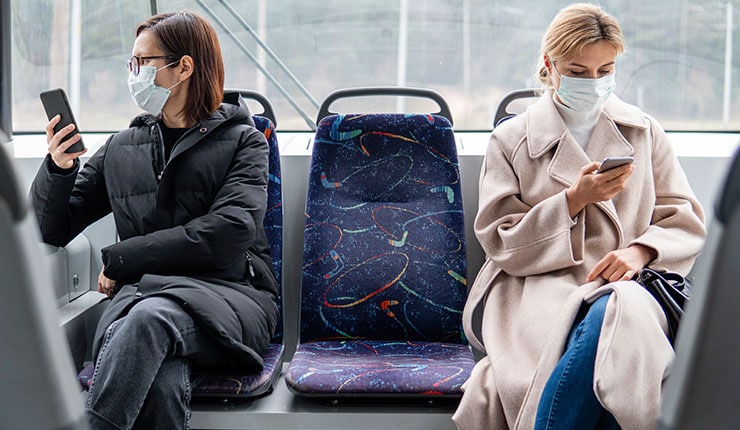There are many steps that you can take to reduce COVID-19 risk, no matter what mode of transport you select when you commute for daily work.
– Nowadays every type of business is getting back on track amid COVID-19 pandemic so, everyone should look after new ways to function which will also keep employees’ health safe.
– In response to this, the CDC has given some guidelines for better practices when you use transport.
– Also, they mentioned that traveling solo for work is the safest form of commuting currently.
– They even advised about being safe when using public transport.
All statistics and data are based on available public data. Many information may be out of date when you go through this article.
Now, businesses are starting again or reopening during the COVID-19 pandemic, they begin to face many challenges about finding ways to protect employees and better way to function. To help businesses grow in this process, CDC (center for disease and prevention) released some trusted guidelines for employee’s safety. Their recommendation includes guidelines about how employees can stay safe when they travel to and from for their work. CDC recommended traveling alone whenever possible.
Safest option is commuting solo
CDC suggests in their recent guidance that one must avoid public transportation if they want to prevent themselves from the transmission of SARS-CoV-2. They suggested that the best way to commute for daily work is through walking, biking and using your personal vehicle. They also suggested that employers should give some type of incentives to their workers so that they try to avoid using public transport for commuting as people are mostly in close contact for a longer period of time when they commute through buses, subways and carpools.
By traveling in your personal vehicle for daily work or sharing vehicles with someone you live or know will reduce the exposure to others and decrease the risk of disease. But if you travel with those who you don’t live with, then you are automatically increasing the danger of exposure to the virus.
Controversy related to the recommendations
It’s somehow controversial about the recommendation given by CDC to travel alone as it raised concerns about how this change will affect our environment. Some say that this will lead to promoting high traffic congestion. It may also reverse gains that are made to reduce carbon emissions. Some people are even concerned about low-income groups and different colored individuals who may face difficulties when they have to follow this advice. After all the criticism, CDC changed their language and added `if feasible` to their recommendation. However, we cannot reduce the potential spread of coronavirus by motivating mass transit. Also, related to low-income workers, encouraging individuals who can afford to commute solo will help those who are forced to commute through public transport as having fewer people using public transit can give them a good choice of maintaining social distancing.
Steps which can help you commute as safe as possible
Some trusted general recommendation is given by CDC that you must follow no matter how you commute:
• Always wash your hands for 20 seconds with water and soap and always keep hand sanitizer with you with 60 of alcohol in it and use it before and after the trip.
• Maintain 6 feet distance between others and yourself if you don’t know that person.
• Always cover your sneezes and coughs and use hand sanitizers after that and throw used tissues in the dustbin.
• Don’t touch your nose, mouth and eyes with your hands.
• Wear a mask or face covering when you are exposed to someone you don’t know and keep a physical distance. This will protect you and others from spreading of the coronavirus.
• Try to avoid travel if you are old or have any disability or any other kind of infection which can put you at greater risk.
• Stay home if you are sick or in contact with people prone to COVID-19.
What if you’re forced to use public transport?

While commuting alone is the safest option but CDC has changed their suggestion to reflect that not everyone will be able to do this. If you commute through public transit or share ride for work then you must follow their general recommendations mentioned above along with some specific guidelines particularly related to mode of transport.
Some of the trusted guidelines for public transport are:
• Don’t touch things- try using touchless payment options and no-touch doors and trash cans. Use hand sanitizer or wash hands after touching any often touched things.
• Stay up to date for any changes made to their procedures and services- this guideline is necessary if you need any special assistance.
• Practice social distancing- try to travel between non-peak hours. Create 6 feet distance from others. Follow social distancing markings or signs created by the local transit authority.
• Improve ventilation- if you are sharing a ride, then you must focus on improving the ventilation like opening windows or using air conditioning.
• Clean and disinfect surfaces- disinfect all those surfaces which are touched frequently.
Summary
CDC suggests that the best way to reduce the transmission of coronavirus which causes COVID-19 is to commute solo for your daily work. While this is the safest option but it can’t be followed by everyone.
To help every worker, CDC has given some general recommendations to follow while using any mode of transportation be it your personal vehicle or any public transit.
